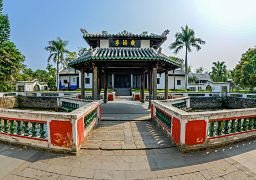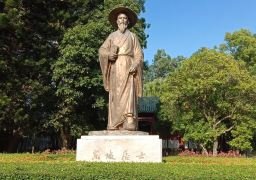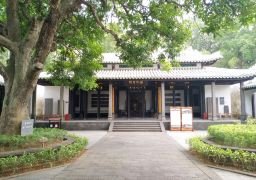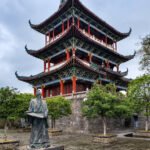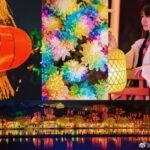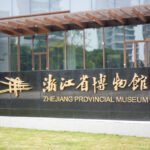Introduction to Dongpo Academy: Dongpo Academy was originally named Zaijiu Hall. It is located in the eastern suburb of Zhonghe Town, Danzhou City. It was a place where Su Dongpo, a great literary master of the Northern Song Dynasty, gave lectures and made friends during his three years in Danzhou. The original site of Zaijiu Hall was the residence of Li Ziyun, a local person. One day, Su Dongpo visited Li Ziyun together with Zhang Zhong, the military commissioner of Changhua Army (i.e., Danzhou), and got together with local people. Everyone proposed that in order to facilitate Su Dongpo’s giving lectures and making friends and civilizing the local area, a lecture hall should be built at Li Ziyun’s place. Su Dongpo gladly approved and named it ‘Zaijiu Hall’, taking the meaning of ‘carrying wine and food and following scholars to study’ from the Biography and Praise of Yang Xiong in History of the Han Dynasty. According to the Record of Zaijiu Hall by Xu Zhi, the registrar of Danzhou in the Yuan Dynasty, Zaijiu Hall was first built in 1098, the fifth year of Shaosheng in the Northern Song Dynasty, that is, more than half a year after Su Dongpo arrived in Danzhou in July of the fourth year of Shaosheng. Since July of 1097, the fourth year of Shaosheng in the Northern Song Dynasty, when Su Dongpo was demoted from Huizhou to Danzhou, until June of 1100, the third year of Yuanfu, Su Dongpo was pardoned and returned north. During his three years in Danzhou, the literary master of his generation cultivated the land by himself, painstakingly advised farmers, changed customs, promoted culture and education, wrote books and made theories, and was respected by the world. At that time, inspired by Su Dongpo’s spirit, the atmosphere of studying and learning culture gradually developed in Danzhou and even the whole Hainan. Jiang Tangzuo, a scholar from Qiongzhou who had received his education, became the first person in Hainan to pass the provincial examination in the second year after his return north. And in the ninth year after his return north, Fu Que from Changhua Army (Danzhou) passed the imperial examination. Since then, Hainan has made a great breakthrough and ended the history of no successful candidates in the highest imperial examinations. Fu Que became the first successful candidate in the highest imperial examinations in Hainan. Therefore, since ancient times in Hainan, Su Dongpo has been regarded as an important contributor to the cultural development and enlightenment of Hainan. And his contribution to the enlightenment of Danzhou culture has been praised for generations. ‘Scholars in Qiongzhou began in Danzhou, and scholars in Qiongzhou are also the most prosperous in Danzhou.’ This is Su Dongpo’s immortal contribution to the cultural development of Danzhou. Today, Dongpo Academy has become a cultural holy land that people from all walks of life and the people of Danzhou look up to for generations. Dongpo Academy was also awarded as a key cultural relic protection unit in 1996 and is one of the important cultural tourist attractions in Hainan. After Dongpo Academy was built in the Northern Song Dynasty, from the Southern Song Dynasty to the early Yuan Dynasty, the hall was abandoned for a long time and there was no record of reconstruction. In the spring of 1328, the fifth year of Taiding in the Yuan Dynasty, Peng Yinglei, the deputy magistrate of Danzhou, rebuilt it on the original site. Later, from the Ming and Qing Dynasties to the early Republic of China, it was reconstructed, added and rebuilt many times. In 1548, the 27th year of Jiajing, it was renamed ‘Dongpo Academy’. Since the liberation of Hainan in 1950, under the care of successive Party and government leaders, Danzhou Dongpo Academy has been effectively protected through management and maintenance. In 1982, it underwent a large-scale renovation and reconstruction, taking on a completely new look.
Especially under the drive of the construction plan of Hainan International Tourism Island. As a cultural relic protection unit, the construction of Dongpo Academy has become one of the key tourism projects in Danzhou City and has achieved greater development in recent years. From 2012 to 2014, the Danzhou Municipal People’s Government carried out large-scale maintenance on the academy, including the main hall, Zaijiu Hall, two verandas, side rooms, Zaijiu Pavilion, front gate, lotus pond, guardrails, Qinshuai Hall, etc. In 2014, a service reception center was added (now changed to Dongpo Fragrance Cultural Center). Relevant tourism service facilities have been improved according to star-rated standards.
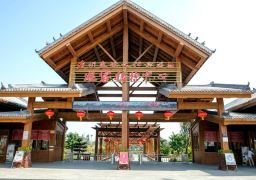
After generations of maintenance and expansion, Dongpo Academy has formed a construction scale of 25,040 square meters. The academy is equipped with antique buildings such as front gate, Zaijiu Pavilion, Zaijiu Hall, main hall, side rooms, east and west verandas, exhibition hall, Qinshuai Hall, Huaixian Pavilion, reception service center, Wangjing Pavilion, Dongpo Private School, etc. There are also scenic spots in the courtyard such as bronze statues of Dongpo in a bamboo hat and wooden clogs and sitting and standing bronze statues, spring ox statues, dogwood flowers, Qinshuai spring well, rockery, etc. The courtyard is full of lush vegetation, dotted with flowers, filled with paintings and calligraphy, and has an antique charm with a strong ‘legacy of Dongpo’.
Dongpo Academy has undergone numerous repairs during the Qing Dynasty, with additional structures such as the main gate, corridors, and side rooms built in the 19th year of the Guangxu era (1893).
In the 23rd year of the Republic of China (1934 AD), it was renovated again, and Dongpo Park and Dongpo Road (then a dirt road) were newly constructed. Due to scholars lecturing in the Zhai Jiutang during the Jiajing era of the Ming Dynasty (1522-1566 AD) to promote the legacy of Su Dongpo, it has been known as the Dongpo Academy. After the national liberation, the people’s government has allocated funds for repairs on multiple occasions. Despite being severely damaged during the Cultural Revolution, from 1983 to 1996, the government allocated substantial funds to renovate structures such as the Zaijiu Pavilion, Panchi, the main hall, Zhai Jiutang, the main gate, east and west corridors, side rooms, Qinshuai Spring, and the academy’s walls. The eastern and western gardens were improved, a bronze statue of Su Dongpo wearing a hat and sandals was erected, and exhibition halls, reception halls, Wangjing Pavilion, and Qinshuai Hall were built. In 1984, a dedicated cultural relic protection agency, the Dongpo Academy Management Office, was established to manage the protection, conservation, and scientific research of Dongpo’s cultural history. On November 20, 1996, Dongpo Academy was declared a fourth batch of national key cultural relics protection units. The size of Dongpo Academy: The area within the current walls is 25,040 square meters, and the area of Dongpo Square in front of the main gate outside the walls is 10.6 mu. The entire text is open from January 1st to December 31st, from 08:30 to 17:30. Preferential policies for children: Free for those under 1.2 meters (inclusive). Elderly: Free for those aged 70 and above with ID; discounted for those aged 60 to 70 (exclusive of 70). Active military personnel: Free with officer, soldier ID, or disabled soldier ID. Disabled individuals: Free with disability ID. Students: Discounted with student ID or school-organized proof. Additional note: The above information is for reference only; preferential tickets must be purchased on-site and are subject to the public notice at the scenic spot.